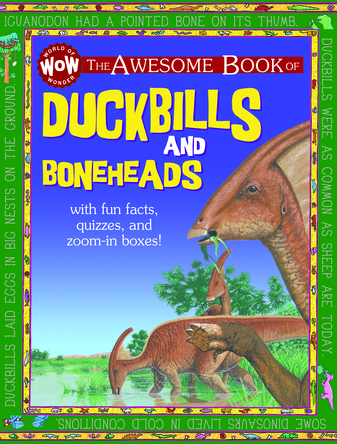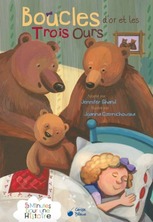Extrait du livre Duckbills and Boneheads
Get ready to hear your kids say, “Wow! That’s awesome!” as they dive into this fun, informative, question-answering series of books! Students—and teachers and parents— will learn things about the world around them that they never knew before! This approach to education seeks to promote an interest in learning by answering questions kids have always wondered about. When books answer questions that kids already want to know the answers to, kids love to read those books, fostering a love for reading and learning, the true keys to lifelong education. Colorful graphics are labeled and explained to connect with visual learners, while entertaining explanations of each subject will connect with those who prefer reading or listening as their learning style. This educational series makes learning fun through many levels of interaction. The in-depth information combined with fantastic illustrations promote learning and retention, while question and answer boxes reinforce the subject matter to promote higher order thinking. Teachers and parents love this series because it engages young people, sparking an interest and desire in learning. It doesn’t feel like work to learn about a new subject with books this interactive and interesting. This set of books will be an addition to your home or classroom library that everyone will enjoy. And, before you know it, you too will be saying, “Wow! That’s awesome!” “People cannot learn by having information pressed into their brains. Knowledge has to be sucked into the brain, not pushed in. First, one must create a state of mind that craves knowledge, interest, and wonder. You can teach only by creating an urge to know.” - Victor Weisskopf
Introduction Find out for yourself all about horned dinosaurs, bonehead dinosaurs, and dinosaurs that had a bill like a duck. Dinosaurs lived on Earth millions and millions of years ago and were among the most successful animals of all time. Scientists called “paleontologists” are constantly unearthing amazing information and making exciting new discoveries about duckbilled, horned, and bonehead dinosaurs. They study their remains, called “fossils,” which have been preserved in ancient rocks. Q: Why watch out for these boxes? A: They give answers to the dinosaur questions you always wanted to ask. Dinosaur bits Look out for these boxes to take a closer look at dinosaur features. Awesome facts Watch out for these diamonds to learn more about the truly weird and wonderful facts about dinosaurs and their world.
Dinosaurs could walk from Africa to America without getting their feet wet. When they lived Dinosaurs lived between 230 and 65 million years ago (mya). This is a very, very long time ago. It’s hard enough to imagine hundreds of years ago, let alone millions. Dinosaurs are dated according to the geological time scale, which is used to age rocks. Geologists work out the ages of ancient rocks by studying radioactive elements in them, and by analyzing fossils. At the start of the age of the dinosaurs, the continents were all joined together as one great supercontinent called “pangaea.” over millions of years, the Atlantic ocean opened up and pangaea split apart. The continents drifted (moved slowly) to their present positions. They are still moving about an inch (a few centimeters) each year. Q: how did a flesh-eating dinosaur become a fossil? A: Small meat-eating animals ate the flesh from dead dinosaurs’ bones. Some bones rotted. Others were buried under layers of sand or mud. These turned into fossils over time, as tiny spaces in the bones filled with rock. Millions of years later, the fossilized bones are uncovered by water or wind action. Paleontologists dig the fossilized bones out of the rock and clean them, making sure they don’t fall apart. They make maps and take photographs at the dig site so that they can tell later exactly where everything was found.
Duckbills were so common that they have been called “the sheep of the Cretaceous.” Horns, bones, and bills Duckbills and their relatives were part of the group of two-legged, plant-eating dinosaurs called “ornithopods.” The bonehead group, called “marginocephalians,” included the boneheads themselves, called “pachycephalosaurs,” and the horn faces, called “ceratopsians.” Duckbills and boneheads were key dinosaurs of the Cretaceous. In the late Cretaceous of Canada, herds of the ornithopod “lambeosaurus” lived alongside the ceratopsian “Styracosaurus” and the smaller pachycephalosaur “Stegoceras.” All the duckbills and boneheads were plant eaters. Awesome facts Duckbills and boneheads traveled in huge mixed herds like modern antelope and wildebeest. Hundreds of skeletons have been found in some fossil beds.
When is a duck not a duck? When it’s a duckbill. What makes a duckbill ? Duckbilled dinosaurs called “hadrosaurs” were the most successful dinosaurs of all. hundreds of their skeletons have been found in late Cretaceous rocks in China, north America, and Mongolia. hadrosaurs had much the same body, but the heads were very different, often with bizarre crests. Although hadrosaurs looked like ducks, and Ossified tendons may have been able to swim, they spent most of their time running about on dry land. Their huge tails were used for balance. Thin rods of bone called “ossified tendons” ran along the side of the tail and over the hips. These helped to keep the tail stiff. Duckbill teeth Duckbills had hundreds of teeth arranged in tight rows, all designed for chopping tough plants. Some had as many as 2,000 teeth in total. One of the best-known duckbills, Corythosaurus of north America, had a crest shaped like half a plate on its head. It had small hooves on its fingers and toes, suggesting that it walked on all fours. however, Corythosaurus also used its hands for grabbing food.



























